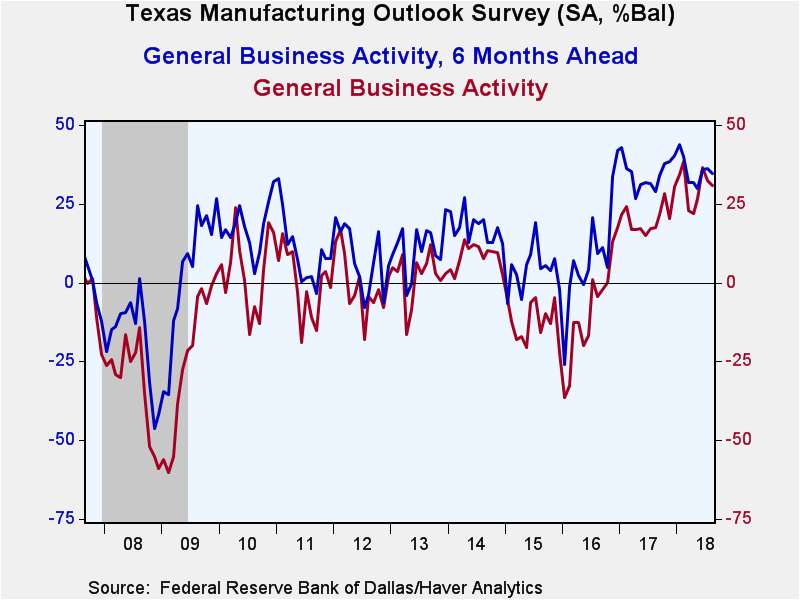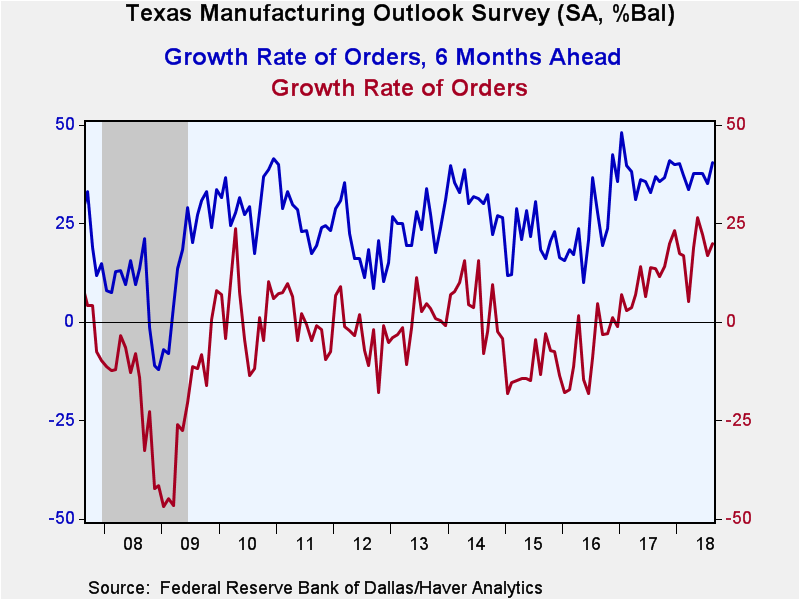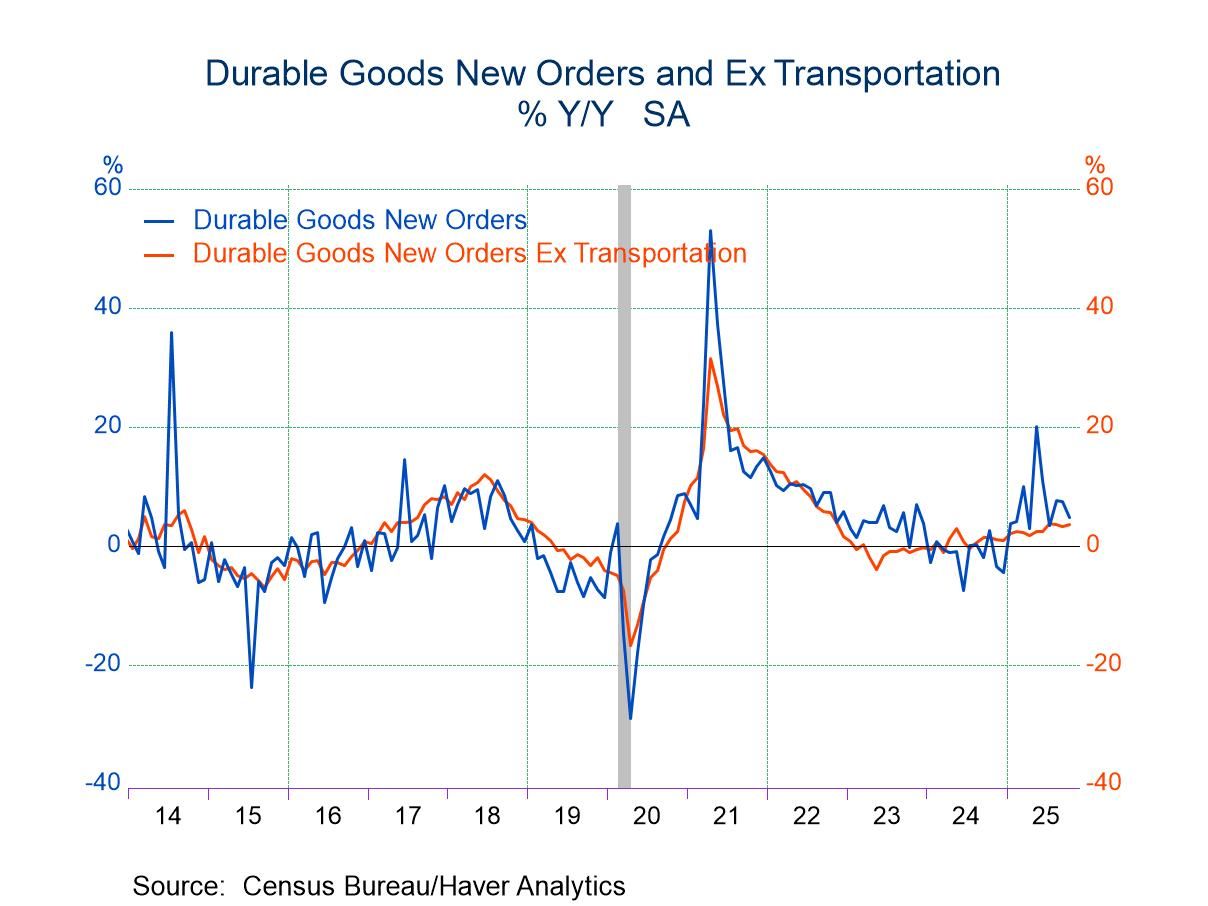 Global| Aug 27 2018
Global| Aug 27 2018Texas Factory Sector Index Slips
by:Tom Moeller
|in:Economy in Brief
Summary
The Federal Reserve Bank of Dallas indicated in its Texas Manufacturing Outlook Survey that the General Business Activity Index fell to 30.9 during August after easing to 32.3 in July. Despite these declines, the index remained up [...]
The Federal Reserve Bank of Dallas indicated in its Texas Manufacturing Outlook Survey that the General Business Activity Index fell to 30.9 during August after easing to 32.3 in July. Despite these declines, the index remained up sharply from its March low.
Movement amongst the sub-series was mixed last month. The growth rate of new orders improved, but production, shipments and delivery times declined. On the labor front, employment held steady at the highest level of the expansion, but the workweek reading eased. The capital expenditures reading slipped m/m but was near the record high.
The index for finished goods prices received declined sharply to the lowest level in twelve months. The raw materials price measure also weakened. The wages & benefits index increased to the expansion high. The figure has doubled in the last nine months.
The index of expected business conditions in six months slipped m/m. Movement amongst the sub-series was mixed. Expected new orders growth improved, but the future production and unfilled orders readings declined. The future shipments series has been steady for several months. The future capital expenditures reading continued to strengthen.
On the labor front, the future employment reading increased to the highest level since January. Future hours worked, however, weakened. Future wages & benefits declined sharply to the lowest level since December.
Each index is calculated by subtracting the percentage reporting a decrease from the percentage reporting an increase. When all firms report that activity has increased, an index will register 100. An index will register -100 when all firms report a decrease. An index will be zero when the number of firms reporting an increase or decrease is equal. Items may not add up to 100% because of rounding. Data for the Texas Manufacturing Outlook can be found in Haver's SURVEYS database.
Some Implications of Uncertainty and Misperception for Monetary Policy from the Federal Reserve Board can be found here.
| Texas Manufacturing Outlook Survey (SA, % Balance) | Aug | Jul | Jun | Aug'17 | 2017 | 2016 | 2015 |
|---|---|---|---|---|---|---|---|
| Current General Business Activity Index | 30.9 | 32.3 | 36.5 | 17.5 | 20.6 | -8.9 | -12.5 |
| Production | 29.3 | 29.4 | 23.3 | 21.0 | 20.2 | 2.4 | -1.0 |
| Growth Rate of New Orders | 19.9 | 17.0 | 22.2 | 13.5 | 11.4 | -7.3 | -11.8 |
| Employment | 28.9 | 28.9 | 23.9 | 10.3 | 11.4 | -4.9 | -0.4 |
| Wages & Benefits | 33.4 | 32.4 | 31.4 | 27.3 | 22.2 | 17.6 | 16.5 |
| Prices Received for Finished Goods | 15.3 | 22.9 | 26.2 | 10.8 | 12.7 | -1.6 | -8.5 |
| General Business Activity Index Expected in Six Months | 34.7 | 36.2 | 35.9 | 29.0 | 34.5 | 8.9 | 4.1 |
| Production | 46.6 | 50.6 | 47.9 | 43.2 | 46.8 | 35.8 | 31.1 |
| Growth Rate of New Orders | 40.4 | 35.1 | 37.7 | 37.0 | 37.7 | 24.3 | 20.7 |
| Employment | 42.2 | 39.9 | 39.8 | 30.6 | 35.2 | 16.8 | 14.7 |
| Wages & Benefits | 45.5 | 53.2 | 53.2 | 44.4 | 43.4 | 34.8 | 33.2 |
Tom Moeller
AuthorMore in Author Profile »Prior to joining Haver Analytics in 2000, Mr. Moeller worked as the Economist at Chancellor Capital Management from 1985 to 1999. There, he developed comprehensive economic forecasts and interpreted economic data for equity and fixed income portfolio managers. Also at Chancellor, Mr. Moeller worked as an equity analyst and was responsible for researching and rating companies in the economically sensitive automobile and housing industries for investment in Chancellor’s equity portfolio. Prior to joining Chancellor, Mr. Moeller was an Economist at Citibank from 1979 to 1984. He also analyzed pricing behavior in the metals industry for the Council on Wage and Price Stability in Washington, D.C. In 1999, Mr. Moeller received the award for most accurate forecast from the Forecasters' Club of New York. From 1990 to 1992 he was President of the New York Association for Business Economists. Mr. Moeller earned an M.B.A. in Finance from Fordham University, where he graduated in 1987. He holds a Bachelor of Arts in Economics from George Washington University.










